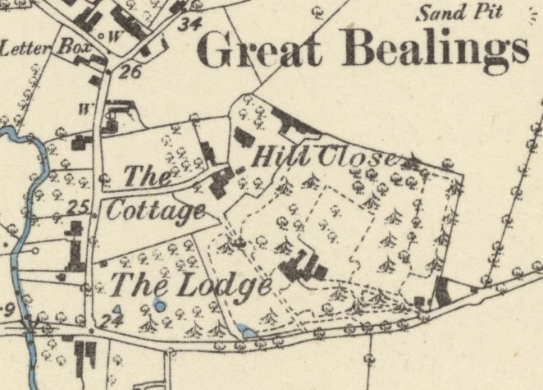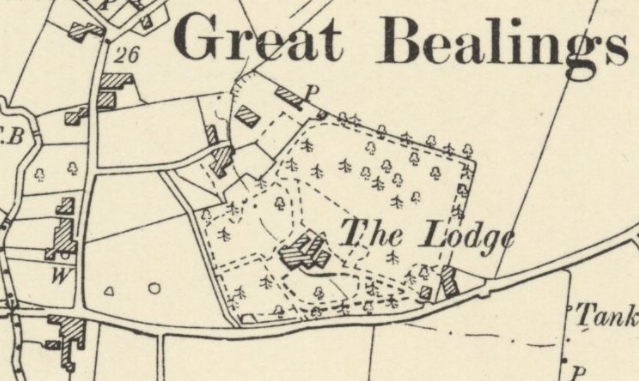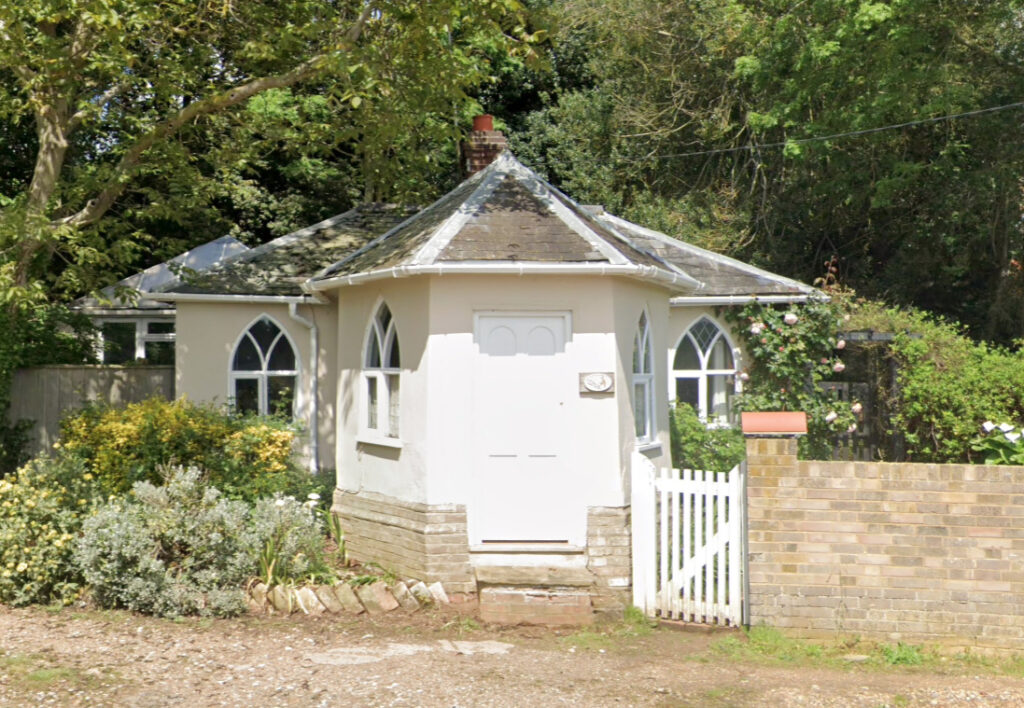(previously (Great) Bealings Place)
Parish: GREAT BEALINGS
District Council: EAST SUFFOLK (previously Suffolk Coastal)
TM 235 484
Not open to the public


Lying on the valley side of the River Lark, The Lodge (Grade II) in Great Bealings is c. 3.5km (2mls) west of Woodbridge in the settlement area of Great Bealings parish known as Lower Street.
The classically-styled house was built in the early-nineteenth century and extended in the mid-nineteenth and twentieth centuries. The Revd Philip Meadows (1777–1837) of Witnesham Hall was rector of Great Bealings from 1804 and is recorded as living at The Lodge during the early-nineteenth century. At the time the glebe house was recorded as unfit for occupation, so it seems likely that Philip was responsible for the construction of The Lodge as a suitable home for a man of his standing in the community. Charles Daniel Meadows (1812–74) inherited his father’s estates and is recorded as owner and occupier of the house on the tithe apportionment of 1839, although at that time it was known as Bealings Place. The accompanying tithe map shows the house within modest, irregularly-shaped grounds sloping gently westward down the valley side towards the River Lark with Charles also owning an arable field immediately to the east of the house. A windmill owned by John Bartrum was to the north and a road running east to west formed the southern boundary. Off this there was a public track or path close to the garden front of The Lodge that formed the western boundary of the grounds. This ran northward towards a house called Mount Pleasant, owned by John Mayhew, and onward to a lane leading to the mill, today known as Orchard Lane – its name derived from an orchard to the west of the track that was owned by Robert Marchant in 1839. The Lodge’s main south-easterly drive gave access to the grounds and south-facing entrance front of the house. A further more westerly subsidiary track or path led to the south-west-facing garden front and linked up to the main drive. In 1844 the Revd Edward James Moor, son of Major Moor of nearby Bealings House, became rector and decided to build a new rectory on land further north and closer to the parish church of St Mary’s (Grade II*) while the Meadows family continued to live at The Lodge. Charles Daniel Meadows, an attorney and bank manager, is recorded as living at the house in 1851 with his family, including his second wife Agnus who was the youngest daughter of John Wood of Melton Hall near Woodbridge.
By 1881 the Meadows family had left The Lodge and it was the home of Charles Oldham, a retired Brigade-Surgeon. The OS map surveyed that year and published in 1884 shows the grounds extending further west, having taken in part of the orchard previously owned by Robert Marchant, with the public track or path towards Mount Pleasant diverted further west and returning to its original route along the northern boundary of The Lodge grounds, while the previous route had become a private track passing the south-west-facing elevation of The Lodge. By this time the arable field to the east had been converted to park-like gardens and a further drive had been added linking the two entrances off the road to the south. A surviving small single-storey south-east entrance lodge in the cottage orné-style had been built had been built by this time that is not shown on the tithe map and so suggestive of a mid-nineteenth century date and the work of Charles Daniel Meadows. The 1884 map shows there were views from the south-west front of the house over a small area of parkland and a further area of gardens to the rear. Lawns dotted with freestanding trees surrounded the house, stables and its offices.

By 1905 the route to Mount Pleasant had been truncated – its main access appears to now be from a lane to the north – and the track forming the western boundary of The Lodge’s grounds was now designated a public footpath. Charles continued to live at The Lodge until his death sometime after 1913, when it was acquired by Captain Barrington Henry Chevallier, who added a square freestanding glasshouse within the gardens to the rear of the house but made few other changes to the grounds. Like Charles before him, Barrington made The Lodge his home until his death in 1930.
The extent of the grounds changed little over the following years, although the glasshouse had gone by the mid-1950s. The Conservative politician and leader of the House of Lords under Margaret Thatcher, Lord Belstead made The Lodge his home from the late-1950s until his death in 2005. Today still a private residence, many mature trees have been supplemented by further planting around the house, although its grounds stay much as they were at the beginning of the twentieth century.
SOURCES:
Birch, Mel, Suffolk’s Ancient Sites Historic Places, 2004.
Burke, J. and J. B., Heraldic Illustrations, Volume I, 1844.
Burke, Sir Bernard, A Genealogical and Heraldic History of the Landed Gentry of Great Britain, 1921.
Debrett’s Baronetage, Knightage, and Companionage, 1931.
Dod, Charles, The Peerage, Baronetage, and Knightage, of Great Britain.
Great Bealings, Little Bealings and Playford Parish Plan (combined parish councils), April 2009.
Great Bealings Parish Council, Great Bealings Neighbourhood Plan, 2016–2030, March 2017.
Kelly’s Directory of Suffolk, 1922.
Journal of the Royal Asiatic Society of Great Britain and Ireland, 1913.
Roth, Andrew, ‘Thatcher’s surefooted but low-key leader of the Lords’ in the Guardian, 6 December 2005.
Transactions of the Epidemiological Society of London, Vol. 19, 1899–1900.
White, William, Directory of Suffolk, 1844, 1855.
Census: 1851, 1881, 1901, 1911.
1839 (tithe map 1838) and apportionment.
1884 (surveyed 1880–81) Ordnance Survey map.
1905 (revised 1902) OS map.
1928 (revised 1925) OS map.
1947 (revised 1938) OS map.
2023 Google aerial map (Imagery © Bluesky, CNES / Airbus, Getmapping plc, Infoterra Lts & Bluesky, Maxar Technologies, Map data © 2022).
Heritage Assets:
The Lodge (Grade II). Historic England No: 1284000.
Church of St Mary (Grade II*). Historic England No: 1030752.
English Heritage Project Ref: 3987, The Aggregate Landscape of Suffolk: The Archaeological Resource, Interim report for Aerial Survey component Areas One & Two: The Felixstowe Peninsula, PDF version 2011.
Suffolk Record Office (now Suffolk Archives):
SRO (Ipswich) HB8/5/32. Estate of Captain Barrington Henry Chevallier of the Lodge, Great Bealings, 1930–31.
Site ownership: Private
Study written: November 2023
Type of Study: Desktop
Written by: Tina Ranft
Amended:
